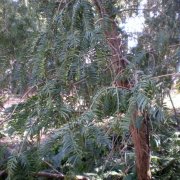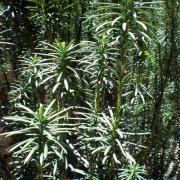Care of the tree Cephalotaxus harringtonia or Japanese plum-yew |
|
The genus Cephalotaxus, family Cephalotaxaceae, comprises 11 species of conifers native to Asia. Some species are: Cephalotaxus harringtonia, Cephalotaxus fortunei, Cephalotaxus sinensis, Cephalotaxus wilsoniana. Common names: Japanese plum-yew, Harrington's cephalotaxus, Cowtail pine. This species is native to Japan. They are evergreen trees or shrubs with a thick and rounded crown that reach 10 meters (32.8 feet) in height. They are very slow growing plants. The shiny leathery leaves are dark green on the upper surface and have two whitish lines on the underside. They produce abundant yellowish flowers on male plants and female plants. The fruits, similar to olives, are decorative. Japanese plum-yew is used as isolated specimens in small or medium gardens, in undergrowths or to form hedges. It's ideal for Atlantic coastal gardens. Cephalotaxus harringtonia prefers a semi-shaded or shaded exposure; they can grow in full sun in cool summer regions. It resists frost well. Cowtail pine tolerates many types of soil (except calcareous ones) but prefers light, well-drained soil with organic matter. Harrington's cephalotaxus is a tree from humid areas that needs frequent watering, waiting until the surface of the land has dried. It does not resist drought. Fertilize with compost in the fall. Japanese plum-yew accepts a light pruning in late winter. Cephalotaxus harringtonia is a resistant plant to the usual pests and diseases. Propagation is not easy as the seeds can take a year and a half to germinate and the cuttings do not root easily. |
Images of the tree Cephalotaxus harringtonia or Japanese plum-yew |
Find plants
Cephalotaxus harringtonia or Japanese plum-yew | Care and Growing
© 2025 FavThemes




